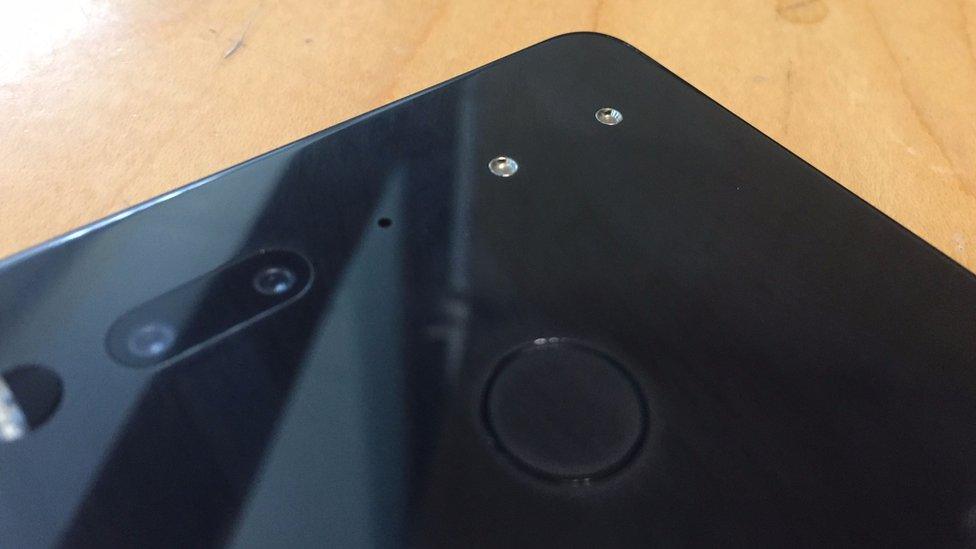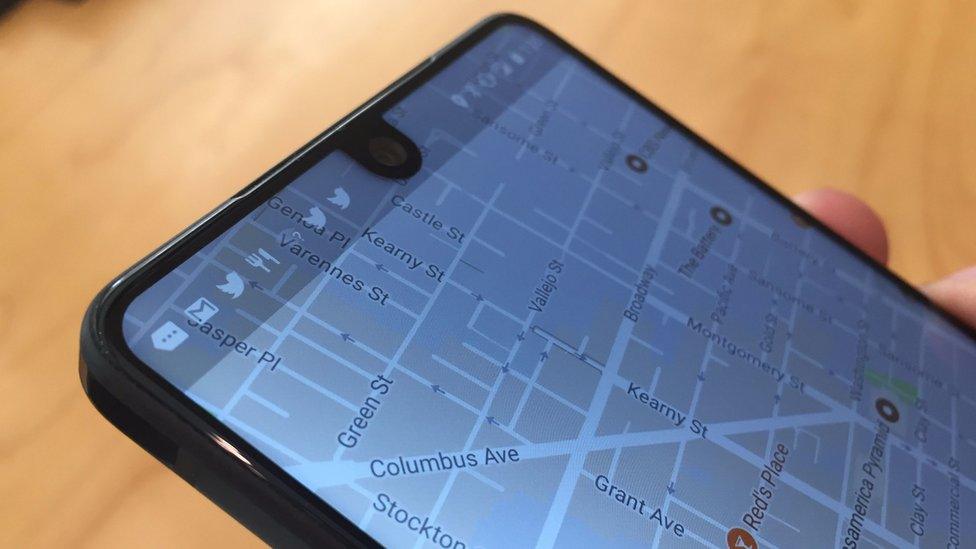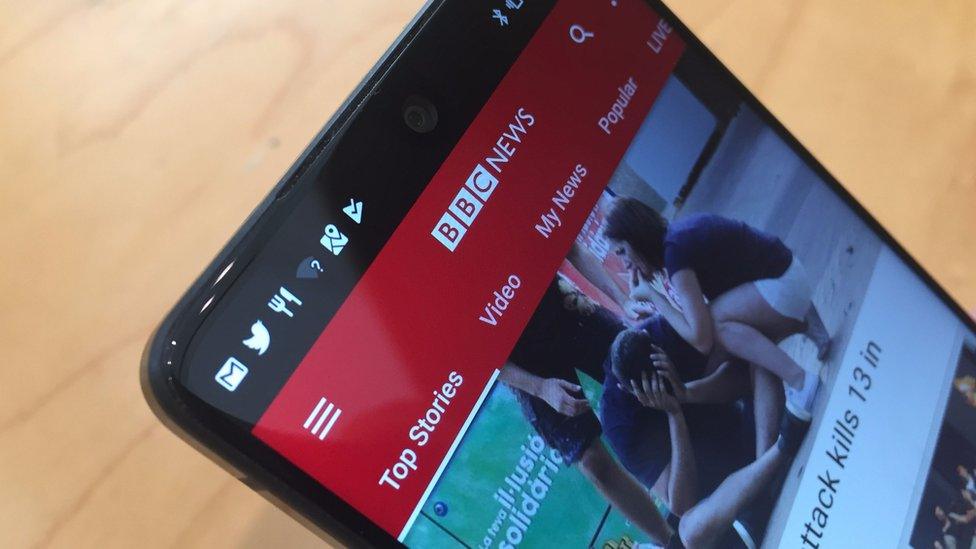Android creator's new phone is great, but is it Essential?
- Published
- comments

Andy Rubin leads an illustrious team of Silicon Valley veterans
"Every now and then I’ll start a company because no-one is walking through my door and pitching it to me,” Andy Rubin tells the group of reporters invited in for “not your typical tech launch”.
He says - and I agree with him - that people are bored with the "incremental updates" offered by Samsung and Apple, and instead want a smartphone that really reflects who they are.
And so out of his pocket he pulls the Essential Phone, a device launched with little fanfare but plenty of expectation: even before Mr Rubin's company sold a single device, it was valued at more than $1bn.
The 55-year-old is best known for creating the most popular mobile operating system today, Google's Android. Here in Palo Alto, he leads a 100-or-so-strong team that estimates they have launched more than 50 successful devices between them, at places such as Apple and Google.
You can find the Essential team within the colourful offices of Playground, Mr Rubin’s investment group. Created in 2015, it funds promising hardware start-ups. Playground is an apt name - the first time I meet Niccolo De Masi, Essential’s president, is as he flies off the end of a slide.
Techies, eh?
Anyway.

Niccolo De Masi, Essential's president, makes his entrance
We’re on the mezzanine, and Mr Rubin has the phone in his hand. There’s no logo on it, or indeed any branding whatsoever. It’s made from titanium, which is lighter and stronger than the aluminium most devices are made from - though the phone itself is heavier overall than, for example, the iPhone 7. Titanium shouldn't bend as much on impact, meaning fewer screen breaks.
It has a ceramic back-casing with a dual-lens camera that doesn’t protrude, so the device can lie flat on its back when resting on a table. There’s an almost-edge-to-edge screen, and, like Google’s Pixel phone, a nifty fingerprint reader on the back to unlock it quickly.
But what makes the Essential Phone different are the two small circular connectors found on its rear. These can be used to snap-on a range of different accessories. The first, a 360-camera, is being offered at a discount when you buy the phone (though they didn’t give me a proper chance to try it out, so I can’t vouch for how good it is).

The Essential Phone's magnetic connector allows for the quick snap-on of accessories
The company has promised a new accessory at least once a month, but there’s no word what those other accessories might be, other than an unremarkable charging dock. It will be interesting to see where this add-on strategy takes them - you may remember that Project Ara, Google’s attempt at making a modular phone, was canned.
Third-parties will be able to make their own accessories, but it remains to be see how many will bother - Essential will have to sell enough phones to make it worth their while.
To help with this, US mobile carrier Sprint is on board. At its flagship stores, a huge display will be pushing the phone.
At $699 (£542), it sits among the high-end devices on the market - and we won’t be seeing any of the predatory pricing we’ve seen from the Chinese manufacturers who have taken on, with moderate success, Apple and Samsung.
So what does the phone have going for it? Most notably for me is simply how it looks and feels - this is the premium smartphone many Android users will have been waiting for. And it serves to highlight the opportunity missed by Google’s own Pixel, a phone that has struggled to sell significant numbers on account of it being rather unremarkable.

The camera is "within" the screen, using part of the display not used by most apps...
In contrast, the Essential Phone has a truly distinctive screen that stretches out across the entire device, save a tiny bezel.
The front-facing camera sits “inside" the screen, creating a little notch that I thought would be distracting, but actually makes a great deal of sense.
It uses up screen space currently wasted by most apps, and means icons showing battery life and signal are tucked away neatly. If you’re watching a video, or an app which needs that particular bit of screen (most don’t), everything moves down by a quarter of an inch so the picture isn’t interrupted.
Like the iPhone, Essential offers a dual-lens rear facing camera set-up - but with a slight twist. One of the phone's sensors is true monochrome (black and white), which when combined with the colour sensor offers superior quality in low-light - not to mention better black and white pictures which, as any photographer will tell you, isn’t just about putting a filter on.

...while apps that use the space hidden by the camera are simply moved down
So let’s return to the question I pose in the headline. Is the Essential Phone an essential purchase? Well, no. There’s nothing here that would tempt you to switch from what you currently use - especially if it means jumping from iOS to Android.
The problem I put to Mr Rubin is that nobody will know about this phone.
He says there won’t be a big event where “one person gets on stage and does a ‘ta-da!’”. You also won’t be seeing a huge advertising campaign, a Super Bowl ad, or anything even close to the kind of effort Samsung has gone to in order to get its devices into consumers’ hands - and that’s a company that has been a known brand for more than 50 years.
The company is cagey about its sales expectations. And Sprint, while clearly prepared to enthusiastically push the device, wouldn’t give me an indication of what constitutes success on its side.
Mr Rubin says he thinks the calibre of the team behind the device, as well as the obvious quality of what they have created, will be enough to shift units.
According to CCS Insight, Samsung controls 23% of the global smartphone market. Essential is starting with the US, but says it has its ambitions set across the developed world and then onto emerging markets.
Can it move the needle in global smartphone sales? From where I’m sitting, maybe - but then I’m in Silicon Valley. Something tells me it’s going to take a big effort to impress anyone beyond this tech-obsessed bubble.
___________
Follow Dave Lee on Twitter @DaveLeeBBC, external
You can reach Dave securely through encrypted messaging app Signal on: +1 (628) 400-7370
- Published31 May 2017
- Published2 September 2016
